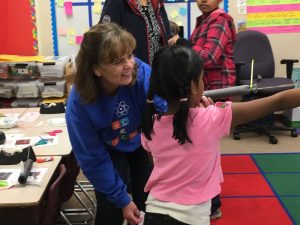Wondering What’s Possible
Two weeks ago, one of the school-wide events I help organize took place. Girls and Engineering Day is held on a Saturday and intended to have the girls that attend my school learn more about STEM fields and experience some engineering design challenges with a family member. The day begins with guest speakers sharing information about their education, place of employment, projects they have worked on or are working on and skills they use in their field. This year there were fourteen guest speakers for my students to choose from. I was honored and thrilled so many women were there to speak about their work. More importantly, this diverse group of women put a real life face to the sometimes imagined view of a scientist or engineer, allowing many of my students to see a version of themselves doing work in science.
Following the guest speakers, students and their parents took part in three different challenge classes that they chose from a list of ten possible options. Classes included: learn to solder, program a microbit, design a slime (chemical engineering), drive DASH the robot, make a maze for an Ozobot, discover Littlebits and Cubelets, a zipline challenge, design a better catapult, design a better foam rocket, sphero water rescue and building challenges (Lego’s, gears, cup towers, blocks, PVC pipe creations etc…)
So much happiness comes out of our building on this day, I feel like we are glowing. I love seeing students engaged in a novel challenge, introduced to a new equipment, challenged to think creatively, learn how to operate a variety of tools, focused on a task interesting to them and engaged in conversations with an adult. The adults were an interesting group to observe, and several categories emerged: The ‘You’re Doing it Wrong, Let Me Show You’; The ‘Scrolling on My Phone, Don’t Even Know What You Are Doing’ and the just right ‘Tell Me What You Think You’ll Try Next’. Which makes me wonder ‘How Might We communicate to parents participation strategies?’ Should some language go home on the fliers? Should the teachers running the classes include a blurb in their intro to the class? Should parents be expected to know intuitively how to best help their child?
The other piece of information I’ve been dwelling on since this event was a comment made by one of the teachers running a class. She noted how engaged all of the students were and laughingly said how that she wishes that happened more in her class (I don’t know that I clearly remember all of her comment, I feel like she mentioned during a specific time) This is not an isolated comment, nor is it an indication of the quality of teacher she is. So where does the wonder get lost? What outside factors are playing a role? How Might We increase opportunities for wonder in the classroom? How might we infuse creativity into reading and math?
Many of my questions come from honest to goodness not knowing. I’ve been teaching in an elementary school for the past eleven years, but have never been an elementary classroom teacher. I’ve never had to teach a struggling reader reach a certain level or a help learning disabled student solve story problems. My colleagues, and other elementary teachers are doing feats like this every day. Because reading instruction is not my expertise, I marvel at their abilities and am awed by what they accomplish. Is it possible to bring the joy that I saw at this event on everyday? What would have to change to make this possible?





